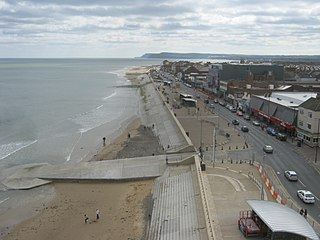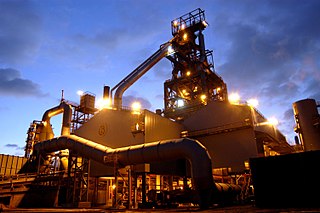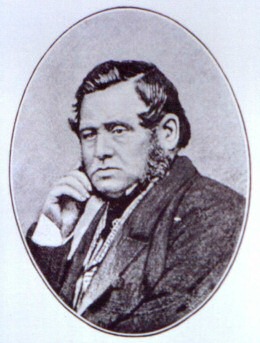
Middlesbrough is a town in the Middlesbrough unitary authority borough of North Yorkshire, England. The town lies near the mouth of the River Tees and north of the North York Moors National Park. The built-up area had a population of 148,215 at the 2021 UK census. It is the largest town of the wider Teesside area, which had a population of 376,633 in 2011.

Redcar and Cleveland is a unitary authority area with borough status in North Yorkshire, England.

Redcar is a seaside town on the Yorkshire Coast in the Redcar and Cleveland unitary authority in the ceremonial county of North Yorkshire, England. It is located 7 miles (11 km) east of Middlesbrough.

Teesside is a built-up area around the River Tees in North East England, split between County Durham and North Yorkshire. The area contains the towns of Middlesbrough, Stockton-on-Tees, Billingham, Redcar, Thornaby-on-Tees, and Ingleby Barwick. Teesside's economy was once dominated by heavy manufacturing until deindustrialisation in the latter half of the 20th century. Chemical production continues to contribute significantly to Teesside's economy.

The Tees Valley is a combined authority area in North East England, around the lower River Tees. The area is not a geographical valley; the local term for the valley is Teesdale. The combined authority covers five council areas: Darlington, Hartlepool, Middlesbrough, Redcar and Cleveland and Stockton-on-Tees.

Tata Steel Europe Ltd. was a steelmaking company headquartered in London, England, with its main operations in the United Kingdom and the Netherlands. The company was created in 2007, when Tata Group took over the British-Dutch Corus Group.

Dorman Long & Co was a UK steel producer, later diversifying into bridge building. The company was once listed on the London Stock Exchange.

Redcar British Steel is a mothballed railway station on the Tees Valley Line, which runs between Bishop Auckland and Saltburn via Darlington. The station, situated 5+3⁄4 miles (9 km) east of Middlesbrough, served the Teesside Steelworks, Redcar and Cleveland in North Yorkshire, England. At the time of the station's closure, it was owned by Network Rail and managed by Arriva Rail North.

Port Talbot Steelworks is an integrated steel production plant in Port Talbot, Wales, capable of producing nearly 5 million tonnes of steel slab per annum. This makes it the larger of the two major steel plants in the United Kingdom and one of the largest in Europe. Over 4,000 people work at the plant.
A Century in Stone is a 2004 documentary film by Craig Hornby. It tells the story of how the discovery of ironstone at Eston in 1850 sparked the transformation of Teesside from rural backwater to iron-making capital of the world.

John Vaughan, known as Jacky, was born in Worcester on "St Thomas' Day" in 1799, the son of Welsh parents. He worked his way up the iron industry, becoming an ironmaster and co-founder of the largest of all the Victorian iron and steel companies, Bolckow Vaughan. Where Henry Bolckow provided the investment and business expertise, Vaughan contributed technical knowledge, in a long-lasting and successful partnership that transformed Middlesbrough from a small town to the centre of ironmaking in Britain.

South Gare is an area of reclaimed land and breakwater on the southern side of the mouth of the River Tees in Redcar and Cleveland, England. It is accessed by taking the South Gare Road from Fisherman's Crossing at the western end of Tod Point Road in Warrenby.

Fire and Steel Festival was a one-day festival held in Redcar, North Yorkshire, set against the background of the industrial furnace of the largest steelworks in Europe and Redcar’s coast line.

Losh, Wilson and Bell, later Bells, Goodman, then Bells, Lightfoot and finally Bell Brothers, was a leading Northeast England manufacturing company, founded in 1809 by the partners William Losh, Thomas Wilson, and Thomas Bell.

Bolckow, Vaughan & Co., Ltd was an English ironmaking and mining company founded in 1864, based on the partnership since 1840 of its two founders, Henry Bolckow and John Vaughan. The firm drove the dramatic growth of Middlesbrough and the production of coal and iron in the north-east of England in the 19th century. The two founding partners had an exceptionally close working relationship which lasted until Vaughan's death.

The Iron and Steel Industry in Scunthorpe was established in the mid 19th century, following the discovery and exploitation of middle Lias ironstone east of Scunthorpe, Lincolnshire, England.
Skinningrove steelworks is a steel mill in Skinningrove, North Yorkshire, England. The business was formed in 1874 as the Loftus Iron Company, after a liquidation of the company reformed in 1880 as the Skinningrove Iron Company. The works expanded from producing only pig iron to include steel production in the early 20th century, with mills specialising in long products including railway rail. As part of the business the company constructed a jetty at Skinningrove, and owned an ironstone mine in Loftus.

Ben Houchen, Baron Houchen of High Leven, is a British Conservative Party politician who was elected as Tees Valley Mayor in May 2017 after winning the 2017 mayoral election, defeating Labour candidate Sue Jeffrey by 2.2 per cent in the second round. He was re-elected in 2021, defeating the Labour candidate, Jessie Joe Jacobs with a landslide 72% of the vote.

Middlesbrough started as a Benedictine priory on the south bank of the River Tees, its name possibly derived from it being midway between the holy sites of Durham and Whitby. The earliest recorded form of Middlesbrough's name is "Mydilsburgh", containing the term burgh.

Redcar Bulk Terminal (RBT), also known as Redcar Ore Terminal, is a privately run dock at the mouth of the Tees Estuary in North Yorkshire, England. The port is used for the transhipment of coal and coke and for many years was the import dock for iron ore destined for Redcar Steelworks under British Steel Corporation, British Steel plc, Corus, Tata Steel Europe and Sahaviriya Steel Industries.





















